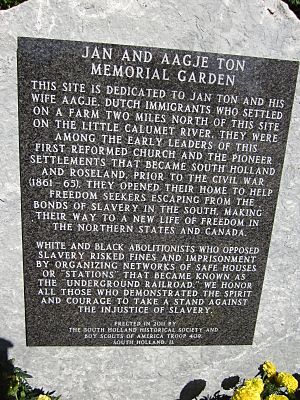John Ton facts for kids
John Ton (born Jan Cornelis Ton) (May 30, 1826 – June 4, 1896) was a man from the Netherlands who moved to America. He became an important abolitionist in Illinois, helping people escape slavery through the Underground Railroad.
John Ton's Early Life
John Ton was born in a small village in the Netherlands. In 1849, when he was 23, he moved to America with a group of other Dutch people. They were looking for a better life.
They settled in an area about 15 miles (24 km) south of Chicago. They called this place "High Prairie," which is now known as Roseland, Chicago. John Ton found farmland even further south, near the Calumet River. This land is now part of the Riverdale community.
In 1853, John married Aggie Vander Syde, who was also a Dutch immigrant. They started a family and eventually had 14 children, all of whom grew up to be adults. In 1859, they bought the farm where they lived.
Helping People Escape Slavery
During John Ton's time, America was facing a big problem: slavery. The country was close to a war over it. Illinois was a key state because it bordered states where slavery was allowed. Leaders like Abraham Lincoln were working to end slavery completely.
John Ton had found a better life in America, and he wanted to help others. He joined with other people in his area who were against slavery. They created a "link" in the Underground Railroad. This was a secret network of safe places and routes that helped enslaved people escape to freedom.
John Ton's farm was a safe house. It was hidden away from the main settlement of Roseland. Enslaved people could hide there until it was safe to move to the next secret location. Sometimes, they would go to Hohman Bridge in Hammond, Indiana. Other times, they might find a ship captain in Chicago who would help them travel to Canada, where slavery was illegal.
In 2000, a group called the Chicago/Calumet Underground Railroad Effort (C/CURE) was formed. They wanted to research and learn more about the John Ton Farm site.
In 2011, the Jan and Aagje Ton Memorial Garden was created. It's located at the First Reformed Church in South Holland, Illinois. This garden honors John Ton and everyone else who helped with the Underground Railroad. In 2019, the National Park Service added the Jan and Aagje Ton Farm Site to its National Underground Railroad Network to Freedom registry. This means it's officially recognized as an important historical site for freedom.
Ton Family Reunions
After John Ton moved to America, seven of his brothers and sisters also came to the Roseland area. They also did well there.
When John Ton passed away in 1896, his family held a picnic to remember him. This included his children, grandchildren, and his brothers and sisters and their families. They decided to make this picnic an annual event for the Ton family.
In 1911, the Ton Family officially formed a group. Their goal was to "keep the family in closer union" and make sure the "annual reunions are a permanent and pleasing feature of the Family." Over time, the family grew to more than 1,000 descendants from John Ton and his siblings. The yearly picnics became a big community celebration that lasted for 60 years. At one point, Life Magazine said it was the largest family reunion in American history!
Images for kids



